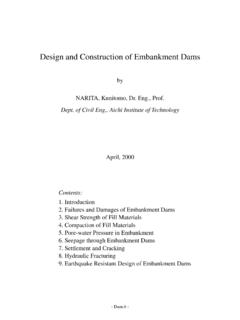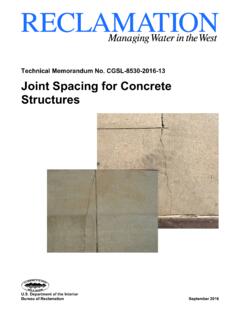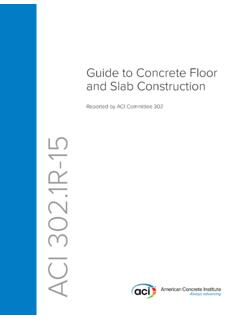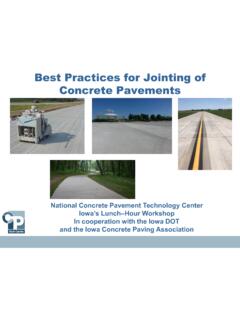Transcription of Design and Construction of Embankment Dams
1 Design and Construction of Embankment Dams by NARITA, Kunitomo, Dr. Eng., Prof. Dept. of Civil Eng., Aichi Institute of Technology April, 2000. Contents: 1. Introduction 2. Failures and Damages of Embankment Dams 3. Shear Strength of Fill Materials 4. Compaction of Fill Materials 5. Pore-water Pressure in Embankment 6. Seepage through Embankment Dams 7. Settlement and Cracking 8. Hydraulic Fracturing 9. Earthquake Resistant Design of Embankment Dams . 1. INTRODUCTION. Preface Dams, which are constructed of earth and rock materials, are generally referred to as Embankment dams or fill-type dams.
2 The history of Construction of Embankment dams is much older than that of concrete dams. It is evident that some earth dams were constructed about 3,000. years ago in the cradles of ancient cultures such as east countries. According to the standard manual provided by the International Commission on Large Dams (ICOLD), in which about 63 member countries are now associated, dams with the height of more than 15m are referred to as "high dams". About 14,000 high dams have been registered up to the present, and more than 70 percent of them are Embankment dams.
3 A recent report on the Construction of high dams has also noted that among about 1,000 of high dams constructed in recent two years, just about 20 percent are concrete dams and remaining 80 percent are Embankment dams. It is thus readily recognized that Construction of Embankment dams is a recent world-wide trend in place of concrete dams. Two major distinct features and advantages are noticed for the Construction of Embankment dams. 1. Rigorous conditions are not required for the dam foundation, while hard and sound rock foundation is necessary for concrete dams.
4 Embankment dams can be constructed even on the alluvial deposit and pervious foundations. 2. Construction of Embankment dams has an economical advantage; , the dam project can be planned in the outskirts of city area because of the merit mentioned above, and Construction materials are principally to be supplied near the dam site. In this brief note, several important issues associated with the Design and Construction of Embankment dams, which engineers often encounter in the dam project, are summarized, and some discussions are given on them by introducing recent development of Design procedures and Construction technology.
5 Types of Embankment Dams Embankment dams are classified into two main categories by types of soil mainly used as Construction materials, such as earthfill dams and rockfill dams. The latter ones further can be classified into a few groups by configurations of dam sections, as one with a centrally located core, one with an inclined core and one with a facing, as shown in The main body of rockfill dams, which should have a structural resistance against failure, consists of rockfill shell and transition zones, and core and facing zones have a role to minimize leakage through Embankment .
6 Filter zone should be provided in any type of rockfill dams to prevent loss of soil particles by erosion due to seepage flow through Embankment . In earthfill dams, on the other hand, the dam body is the only one which should have both structural and seepage resistance against failure with a provided drainage facilities. The dam type in a project is determined by considering various factors associated with topography and geology of the dam site, and quality and quantity of Construction materials available. The inclined core is adopted instead of the center core, for instance, in cases where the dam foundation has a steep inclination along the river, where a blanket zone is provided in the pervious foundation to be connected with the impervious core zone, and where different Construction processes are available for the placement of core and rockfill materials.
7 Key Words: rockfill, transition .. pervious zone, to have structural strength core, facing .. impervious zone, to keep water tight filter .. to prevent loss of soil particles drain .. to pass water from upstream to downstream (to dissipate pore water pressure). core trench, grouting .. to keep water tight in the foundation (a) Homogeneous Earth Dam Phreatic surface Drain (b) Rockfill Dam with a Centrally Located Core Filter Outer Shell Inner Shell (Transition) Core Core Trench Curtain Grouting (c) Rockfill Dam with an Inclined Core Filter Random Drain Shell Core Curtain Grouting (d) Rockfill Dam with a Facing Facing Shell Earth and Rockfill Dams.
8 Investigation, Design and Construction There are three main steps of working in a dam project: , investigation, Design and Construction . Individual works in these three steps are summarized as listed in with key words associated with them. Key Words Associated with Investigation, Design and Construction #Site Investigation: Check of dam planning for appropriate purposes /Meteorological and hydrological surveys /Topographical and geological investigations (landform, terrace, geological time, outcrop, lithofacies, folding, fault, discontinuity, erosion, weathering, sedimentation, stratum).
9 #Foundation Survey: Check of required conditions for a base foundation /Geophysical exploration (seismic prospecting, electrical prospecting, ..). /Boring exploration (core drilling, sampling, sounding), /Test pitting /In-situ testing (permeability, grouting, bearing capacity, compressibility). /Rock classification #Fill Materials: Check of required quality and quantity of materials /Geological survey (stratum, volume). /Laboratory testing (shear strength, compressibility, compaction, permeability,..). /In-situ testing (roller compaction, density log, field permeability, sampling).
10 #Stability of Dam Body /Stability against sliding failure of Embankment (evaluation of pore-water pressure during and after Construction , shear strength and deformation characteristics of fill materials). /Seismic stability (seismic coefficient method, liquefaction, dynamic deformation characteristics, dynamic response analysis, earthquake resistant Design ). /Stability at the contact face of dam body and base foundation (contact clay, compaction, relative displacement, arching, cracking). #Seepage Through Embankment and Foundation /Seepage analysis (discharge, pore-water pressure, leakage through foundation, critical velocity, piping, critical hydraulic gradient, hydraulic fracture).








